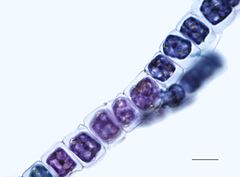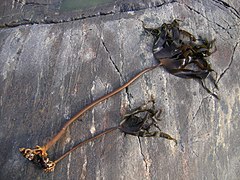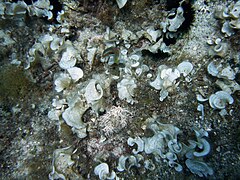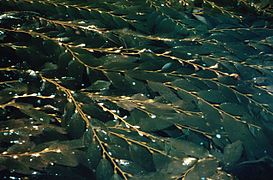Phaeophyceae
The brown algae or pheophyceans or brown algae (class Phaeophyceae) are a group of algae included in the protist kingdom. They are not true plants as they are classified in the Heterokonta group. It comprises about 265 genera with about 1,500-2,000 species, mainly marine since only six genera are freshwater. Brown algae are the main primary producers of various animal and protist communities.
Most of them live on the rocky coasts of the temperate and subpolar zones, dominating the intertidal zone as in the case of the Fucales and Laminariales. Macrocystis, which forms prominent underwater forests, can reach up to 60 m in length. They also occur in free-floating forms, such as Sargassum, which forms large tracts (about the size of a province) in the Sargasso Sea.
Brown algae comprise multicellular forms with differentiated tissues. They generally present rhizoid, stipe and blades. The stipe of some forms may be provided with a sieve of tubes capable of transporting water and products of photosynthesis. As pigments they present chlorophylls a, c1 and c2 and fucoxanthin. The latter is responsible for the brown color of these algae. Chloroplasts are surrounded by four membranes, so it is assumed that they are the result of secondary endosymbiosis of a red alga.
Morphology
Shapes and sizes
Brown algae come in a wide variety of sizes and shapes. The smallest members of the group consist of only a few cells, thus constituting microscopic algae. Others grow as tufts of threadlike cells no more than a few centimeters long. Other groups of brown algae grow to much larger sizes, for example, kelp and sargassum are often the most conspicuous algae in their habitats. Kelp it can vary in size from the 50 cm sea palm (Postelsia) to the 60 m giant kelp Macrocystis pyrifera, which is the largest of all known algae. In terms of shape, brown algae range from small crusts attached to the substrate to leafy floating clumps formed by sargassum species. They range from delicate strands of cells, as in Ectocarpus, to broad flattened fan-shaped branches, as in Padina.
Regardless of size or shape, two conspicuous characteristics distinguish Phaeophyceae from all other algae. First of all, the members of the group present a characteristic color that goes from olive green to various shades of brown. The particular hue depends on the amount of fucoxanthin present in the alga. Second, all brown algae are multicellular. There are no known species to exist as single cells or as colonies of cells, so brown algae are the only major group of algae that does not include such forms. However, this may be the result of classification and not a consequence of evolution, since all groups that are close relatives of brown algae include unicellular or colonial forms.
Visible structures
Whatever their shape, the body of brown algae is called a thallus, meaning they lack the complex xylem and phloem tissues of vascular plants. This does not mean that brown algae are completely devoid of specialized structures. But, because botanists define (true) stems, leaves, and roots by the presence of these tissues, their absence in brown algae means that the stem-and-leaf-equivalent structures present in some groups of brown algae must be described using different terminology. Although not all brown algae are structurally complex, they typically possess one or more characteristic parts.
A rhizoid is a structure equivalent to the root, present at the base of the algae, which serves to fix the substrate and which, unlike the root, is not used as the main organ for the uptake of water or nutrients. The appearance of the rhizoid in brown algae is varied: it can be highly branched or disk- or bulb-shaped.
The stipe, equivalent to the stem, can grow as a short structure at the base of the alga, as in Laminaria, or grow into a large structure, as in Sargassum or Macrocystis. In the more structurally differentiated brown algae, such as Fucus, the tissues within the stipe are divided into three distinct layers or regions. These regions include a central pith, surrounding cortex, and outer epidermis, each of which has its analogue in the stem of a vascular plant. In some brown algae, the pith region includes a nucleus of elongated cells that resemble the phloem of vascular plants, both in structure and function. In others (as in Nereocystis), the center of the stipe is hollow and, being full of gas, serves as a support for the alga. The stipe may be relatively flexible and elastic in species such as Macrocystis pyrifera that grow in strong currents, or it may be more rigid in species such as Postelsia, which are exposed to the atmosphere during low tide.
Laminae are the flat parts of algae that are equivalent to leaves. Some brown algae have a single blade, while in others they are numerous. These blades may be attached directly to the stem, directly to the rhizoid if the stem is absent, or there may be an air gap between the stem and the blade. The foil surface can be smooth or wrinkled; their tissues can be thin and flexible or thick and leathery. In species such as Egregia menziesii, this characteristic can vary depending on the turbulence of the waters in which it grows. In other species, the surface of the blade is coated with silt to discourage the attachment of epiphytes or to deter herbivores. The blades are often also the parts of the alga that support the reproductive structures.
Gas-filled vesicles called pneumatocysts provide buoyancy to many laminae and members of the Fucales. These bladder-like structures are often located on or near the sheets to keep them closer to the water surface and receive more light for photosynthesis. Pneumatocysts are generally spherical or ellipsoidal, but can vary in shape between different species. Species such as Nereocystis luetkeana and Pelagophycus porra have a single large pneumatocyst between the upper part of the stipe and the base of the blades. In contrast, the giant kelp Macrocystis pyrifera has many blades along its stipe, with a pneumatocyst at the base of each blade, where it joins the central stipe. Sargassum species also have many blades and pneumatocysts, but both types of structures are separately attached to the stipe by short stalks. In Fucus species, pneumatocysts develop within the lamina itself, either as individual spherical bladders or elongated gas-filled regions that follow the contour of the lamina in which they develop.
Growth
Brown algae are the largest and fastest growing marine algae. The sheets of Macrocystis can grow up to 50 cm per day, while the stipes can grow up to 6 cm per day.
Growth of brown algae occurs at the end of structures as a result of divisions of a single apical cell or a row of such cells. When this apical cell divides, the new cells it produces give rise to all tissues of the alga. Branching and other lateral structures appear when the apical cell divides to produce two new apical cells. However, some groups such as Ectocarpus grow diffusely, since the production of new cells can occur anywhere on the thallus.
Tissue organization
The simplest brown algae are filamentous, that is, their cells are elongated with separating septa between them. These branch by forming wider ends and dividing the enlargement.
Apart from the filamentous forms, there are two main types of tissue organization in brown algae: pseudoparenchymal (haplostic) and parenchymal (polistic). The lamellae can be multiaxial or monoaxial in type.
The cell wall is made up of two layers: the inner layer is made of cellulose and is strong and therefore supports it, while the outer layer is made mostly of algin and is sticky when wet but becomes hard and brittle when dry.
Life Cycle
Brown algae are all multicellular and always reproduce sexually, although there is great variability from one group to another. Sexual reproduction can be by isogamy, anisogamy, or oogamy. In the latter case, the gametophytes can be female or male, giving rise to ovules and spermatozoa, respectively. The latter are biflagellate, with a mastigonemate flagellum directed forwards and a smooth one directed backwards. The union of the gametes can take place in the water or, in the case of oogamy, in the oogonium. The zygote germinates in response to certain light conditions. However, the life cycle shows great variability from one group to another. Thus, two types of basic cycles are distinguished:
- Monogenetic. It includes a single type of generation, as the zygote gives rise directly to new gametophytes, closing the cycle. It is presented in Fucales.
- Digenetic. In this case the diploid organism that develops from the zygote receives the name of sporophyte and produces spores. The spores develop and give rise to new gametophytes, closing the cycle. There are both isomorphic (or monomorphic) cycles in which sporophytes and gametophites present a similar form, such as heteromorphic (or dimorphic) cycles in which sporophytes and gametophytes are different. In the latter case you can dominate the sporophyte or do the gametophyte. For example, the life cycle Laminaria consists of a diploid generation, which is the great plant that most people know. It produces specialized microscopic structure sporanges that are divided by meiosis before spores are released. There are equal numbers of male and female haploid spores.
Classification
Brown algae belong to the phylum Ochrophyta (heterokontos), a large group of eukaryotic organisms distinguished by having chloroplasts surrounded by four membranes, suggesting a symbiotic relationship between a basal eukaryote and a photosynthetic eukaryote. Most brown algae contain the pigment fucoxanthin, which provides the distinctive green-brown color that gives the group its name. Brown algae are unique among heteroconts in that they develop multicellular organisms with differentiated tissues, but reproduce by means of flagellate spores, which resemble other heterocont cells. Genetic studies show that its closest relatives are the yellow-green algae (Xanthophyceae).
Brown algae appear in the fossil record in the Mesozoic, possibly as early as the Jurassic. Its occurrence as a fossil is rare, due to a generally soft body. Other groups of algae such as the red algae (Rhodophyta) and green algae (Chlorophyta) include some calcareous members, which are more likely to leave traces in the fossil record than the soft organs of brown algae. Miocene fossils of a large soft-bodied brown alga, Julescrania, have been found in a good state of preservation in the Monterey diatomite formation. A few other older specimens are also known from the fossil record, although their identification is difficult.
Phylogeny
The following relationships have been established (2014):
| Phaeophyceae |
| |||||||||||||||||||||||||||||||||||||||||||||||||||||||||||||||||||||||||||||||||||||||||||||||||||||||||||||||
Galería
Contenido relacionado
Petal
Proteaceae
Lepturus
















